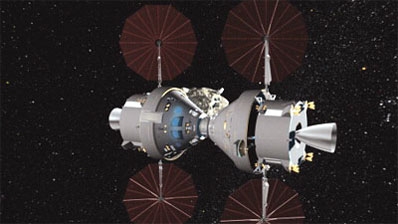
Dual Orion capsules studied for manned asteroid missions
BY CRAIG COVAULT
August 17, 2009
A manned asteroid mission using two Orion spacecraft, docked nose-to-nose to form a 50-ton deep space vehicle, is being studied by Lockheed Martin Space Systems as an alternative to resumption of U.S. lunar landing missions.
snip
The docked Orion configuration as shown in a Lockheed Martin graphic (above) would have a total of four large solar arrays and two service modules as well as two command modules for extra space on the several week flight. Single 25-ton Orion spacecraft would first be used to replace the space shuttle for servicing the International Space Station. But use of them for asteroid missions and other deep space sites would maximize utilization of the Orion system if lunar landings are deleted as a near term goal.
snip
In fact a Lockheed Martin video titled "Orion For Crewed Science Missions" shows the twin Orion configuration closely orbiting an asteroid while space suited astronauts explore its surface. With the minuscule gravity of an asteroid, astronauts flying manned maneuvering units could travel between the Orion combo and the object without ever requiring a much heavier, and expensive, asteroid landing vehicle.
snip
Duffy's presentation also cited satellite servicing that could be performed by astronauts from an Orion configuration, equipped with a shuttle-type manipulator arm deployed from its service module.
The presentation also discussed use of single Orion spacecraft to service geosynchronous orbit military and civilian satellites and the potential for them to travel to Lagrangian points to service telescopes like the giant new Webb space telescope set for launch in about four years. Lagrangian points balance out gravity from the sun, Earth and moon allowing spacecraft to remain parked at those locations. They are about 1 million mi. from Earth, about the same distance as some asteroids passing near Earth. This means Orions configured for missions to telescopes, like Webb, at Lagrangian points would have a life support capability also generally suitable for asteroid missions.
snip
http://www.spaceflightnow.com/news/n0908/17orion/